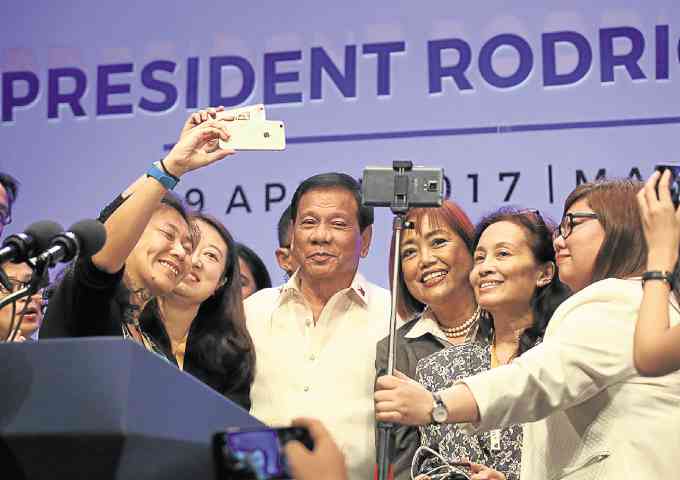‘Asean Fiesta’ caps 30th summit in Manila

President Duterte gamely poses for selfies with women journalists after his press conference at the Philippine International Convention Center. —JOAN BONDOC
The 30th Association of Southeast Asian Nations (Asean) Summit might have been a serious gathering of 10 member-states threshing out controversial issues, but the gala dinner on Saturday lent a vibrant and colorful note to President Rodrigo Duterte’s debut as an international host.
Mr. Duterte hosted 800 guests at the gala dinner that had the theme “Asean Fiesta” to showcase “a night of the best Filipino cuisine and entertainment” at the Grand Ballroom of Sofitel Philippine Plaza Manila.
The 10 Asean leaders cut striking figures in Rajo Laurel-designed barong Tagalog inspired by Mindanao’s ethnic tribes, while their spouses were resplendent in Rhett Eala creations made from gazar or mikado, and crepe fabric.
The guests were treated to a display of the country’s brand of hospitality, from rondalla music, folk tunes and local chart-toppers, to indigenous dances from the Cordilleras, Pangasinan and the Southern regions.
Best foot forward
Article continues after this advertisementThree design motifs featured Philippine art and culture: the Maranao dance, singkil; the traditional tapestry called t’nalak from the T’bolis of South Cotabato; and the sarimanok, a colorful legendary bird said to be a symbol of good fortune.
Article continues after this advertisementAt the end of the long day, the verdict was in: the Philippines “put its best foot forward,” and its populist leader was on his best behavior.
“He was presidential,” said former Philippine Permanent Representative to the United Nations and former Foreign Undersecretary Lauro Baja, who said that Mr. Duterte read his prepared statements according to plan and did not make any outrageous statements as he was wont to do.
“That should be the case,” he told the Inquirer by phone.
Before the gala dinner, the mercurial Mr. Duterte held a press conference where, at one point, when asked about young criminals, he visibly struggled to refrain from cursing.
Baja also gave a glowing endorsement of the President’s common-law wife, Cielito “Honeylet” Avanceña, who hosted the spouses of the Asean leaders on a tour of the National Museum and a luncheon earlier on Saturday.
Though Mr. Duterte’s decision to send someone who was not his legal wife may be peculiar in diplomatic circles, Baja said it only served to emphasize how atypical the current Philippine government is.
“It’s not common, but the situation in the Philippines is not common,” he said. “The important thing is, the hostess did quite well and performed what was expected of her,” Baja added.
Social Welfare Secretary Judy Taguiwalo credited the national organizing committee headed by Mariano Paynor Jr., Malacañang’s chief protocol officer, for its “tremendous work.”
“(The event) was full of activities but the national organizing committee was on top of everything,” she said at a press briefing.
The lack of substantive talks during the four-day meet in Manila and the Philippines’ actions that seemed to indicate it was “under the shadow of China” displeased Baja, but the retired diplomat conceded that, in terms of hosting, “we’re second to none.”
“We put our best foot forward in terms of hospitality, and our arrangements were excellent,” he said.
The Asean heads were presented with wooden trays made of Philippine mahogany that had a brass etching. Their spouses were gifted with cheese plates made of clear tempered glass.
The tokens came with two design accents: a brass kulintang, a native percussion instrument, and a brass sarimanok.